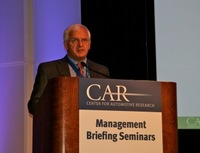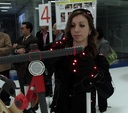C.A.R. Management Briefing Seminars 2013 - Day One

CAR CEO Jay Baron
|
CENTER FOR AUTOMOTIVE RESEARCH
MANAGEMENT BRIEFING SEMINARS
DAY ONE 2013
By Steve Purdy
Photos By Bob Benko
The Auto Channel
Michigan Bureau
Downtown Traverse City is abuzz with movie buffs this unseasonably
cool first Sunday in August as Michael Moore’s film festival winds
down. Across town preparations are underway for the Center for Automotive
Research’s annual Management Briefing Seminars at the magnificent
Grand Traverse Resort. We’ll spend the next few days immersed in the
important issues that define the automobile industry and we’ll try to
sort out and share the less esoteric, more interesting tidbits that might
intrigue our readers. We’ll post a story per day, so stay tuned.

|
From its humble beginnings at the University of Michigan over 35
years ago and its transformation in 2003 into an independent nonprofit research organization dedicated to providing service to the automotive industry.
Center for Automotive Research has grown into one of the
world’s most important research institutions hosting dozens of
conferences and events every year related to nearly all elements of
automobile business and technology. Funding from a variety of government,
industry and academic entities support projects and programs on the leading
edge of the industry. The Management Briefing Seminars here on
Michigan’s “Gold Coast” is the ideal venue to share much
of what is learned as we have some fun in this beautiful resort area.

|
A modest press conference in the lower atrium of the conference
center on Sunday evening took the classic, dramatic form of a shapely car
under a silky cover waiting to be revealed. Students and faculty from
Clemson University in Spartanburg, SC, officials from Mazda, a young
designer from Art Center College of Design in Pasadena, CA, along with
Stewart Reed, ACCD Transportation Design Chairman, took turns telling the
story of the car under the cloth. Then they pulled back the cover to a
murmur of appreciation by the assembled few. One attendee started getting
her checkbook out hoping to buy one. But, on closer inspection, it was
obvious it is only a concept car far from fully sorted.
This student project involved building a car from scratch (not based
on any existing platform) to a stringent set of specifications, in this
case a six-passenger car that would appeal to twenty-somethings at a
targeted theoretical price of less than 30 grand. So, combining the
creativity of these youngsters, the involvement of dozens of suppliers, and
the backing of Mazda this advanced and beautiful car emerged, incorporating
advanced technologies and ones we’ve not heard of, like
origami-folded body panels, ultra light-weighting with aluminum, an unusual
hybrid power train and an unheard of 3 + 3 seating configuration.

|
Monday morning begins the formal sessions with a Fiat/Chrysler exec
talking about worker training and a VW guy reviewing the early successes of
the new Chattanooga plant. Down the hall we find a display of motion
capture technology. (More on that later.) And, outside on the lawn is
VW’s record-setting, high-mileage diesel Passat and the universally
acclaimed new Corvette. You can get your checkbook out for the latter as
they are due in dealer showrooms very soon.
Vendors line the public spaces outside the conference rooms, some we
know well like Continental Automotive, and others we’ve never heard
of like a German screw and rivet maker whose name we can’t pronounce.
Venders who deal in software, hardware, design, business services,
manufacturing technology and more vie for the attention of 900 attendees
and over 50 journalists from around the world.

|
Continental brought a Cadillac XTS fitted with demonstrations of a
variety of active safety systems they have under development. The central
component of the prototype “driver focus” system (potentially
in cars by 2016) is an inexpensive, low-tech, black-and-white camera
mounted on the steering column facing the driver. With sophisticated,
complex software and algorithms it is capable of facial recognition, so it
can identify each driver and anticipate his/her preferences, and it can
read eye movements, direction of attention and other variables to assess
alertness and distraction. All of this information integrates with tactile,
visual and auditory signals to keep the driver focused and safe.
Zachary Bolton, the young man who walked me though these systems,
started out as a mechanical engineer but found his way to software
engineering, one of the most sought-after specialties in the automobile
engineering field. We’ve heard much commiseration within the
automobile design and manufacturing communities these past few years about
the difficulty in finding the right engineers to fill a myriad of
vacancies. On first blush that might defy conventional wisdom with the
unemployment level, including within engineering, so high. But, it is these
more specialized kinds of jobs that are so hard to fill, we’re told.
Now, let’s get back to that motion capture display.
The World Class Manufacturing Academy is part of Chrysler and came
on line when Fiat took over the company after the bankruptcy. Our host at
the display (sorry I didn’t get his name) was working at
Chrysler’s nearly new Dundee, MI plant where they thought they were
doing well on efficiency and ergonomics, but they found that not to be the
case once they took on Fiat’s system. With “motion
capture” suits and creative training methods they can take an amazing
amount of wasted, difficult or injurious motion out of any assembly task.
With a worker dressed up in the same kind of suit used by movie and
video game developers to accurately duplicate movement, monitors read and
record movements in minute detail. Training protocols then structure a
duplicate task so that teams in training can improve processes in
measurable ways. Psychology is a big part of the training as well with
competition among teams in training and a affirmation that line workers are
in the best position to evaluate the task at hand. The Academy has trained
over 5,000 Chrysler workers so far and will do many more.
Tomorrow we’ll take a closer look at that VW diesel referred
to earlier and whatever else I think will tickle your fancy. One of the most productive
elements of the conference is the two hours of hospitality under the yellow
tent just after the sessions end and we’re headed there now.
© Steve Purdy, Shunpiker Productions, All Rights
Reserved









